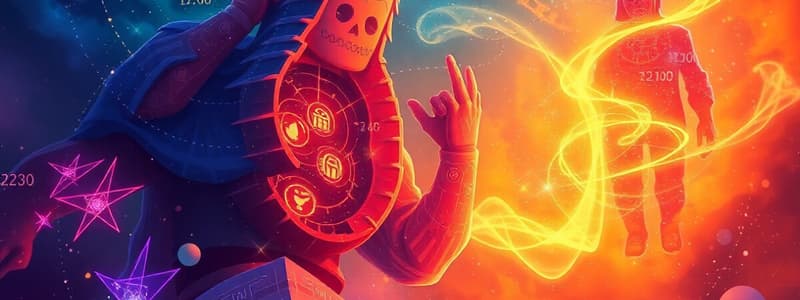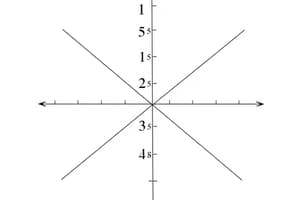Podcast
Questions and Answers
Which of the following statements accurately describes the relationship between different sets of numbers?
Which of the following statements accurately describes the relationship between different sets of numbers?
- All rational numbers are integers.
- All integers are irrational numbers.
- All integers are whole numbers.
- All whole numbers are rational numbers. (correct)
The number $\pi$ can be expressed in the form p/q, where p and q are both integers.
The number $\pi$ can be expressed in the form p/q, where p and q are both integers.
False (B)
What is the additive inverse of -15?
What is the additive inverse of -15?
15
The property that states $a * (b + c) = a * b + a * c$ for any integers a, b, and c is known as the ______ property.
The property that states $a * (b + c) = a * b + a * c$ for any integers a, b, and c is known as the ______ property.
Match the following numbers with their corresponding sets:
Match the following numbers with their corresponding sets:
Which of the following sets demonstrates closure under multiplication?
Which of the following sets demonstrates closure under multiplication?
The absolute value of any integer is always a positive number.
The absolute value of any integer is always a positive number.
If the temperature is -8°C and it increases by 12°C, what is the final temperature?
If the temperature is -8°C and it increases by 12°C, what is the final temperature?
The identity element of addition for integers is ______.
The identity element of addition for integers is ______.
Which property is demonstrated by the equation $5 + (-5) = 0$?
Which property is demonstrated by the equation $5 + (-5) = 0$?
Flashcards
Rational Number
Rational Number
A number that can be expressed as a fraction p/q, where p and q are integers and q is not zero.
Whole Numbers
Whole Numbers
Basic counting numbers starting from zero. They are non-negative integers without fractions, decimals, or negatives.
Integers
Integers
Include all whole numbers (0, 1, 2, 3,...) and their negatives (...-3, -2, -1, 0, 1, 2, 3,...). They do not include fractions or decimals.
Closure under Addition (Integers)
Closure under Addition (Integers)
Signup and view all the flashcards
Closure under Multiplication (Integers)
Closure under Multiplication (Integers)
Signup and view all the flashcards
Commutativity of Addition (Integers)
Commutativity of Addition (Integers)
Signup and view all the flashcards
Commutativity of Multiplication (Integers)
Commutativity of Multiplication (Integers)
Signup and view all the flashcards
Associativity of Addition (Integers)
Associativity of Addition (Integers)
Signup and view all the flashcards
Associativity of Multiplication (Integers)
Associativity of Multiplication (Integers)
Signup and view all the flashcards
Additive Inverse (Integers)
Additive Inverse (Integers)
Signup and view all the flashcards
Study Notes
- Math is the study of topics such as quantity, structure, space, and change
- Other views can be found, and mathematicians seek out patterns and formulate new conjectures
Rational Numbers
- A rational number is any number that can be expressed as the quotient or fraction p/q of two integers
- p is a numerator and q is a non-zero denominator
- Since q may be equal to 1, every integer is a rational number
- A rational number can be expressed as a terminating decimal or a repeating infinite decimal
- 0 is a rational number
- It can be written as 0/1
- 5 is a rational number
- It can be written as 5/1
- 1.5 is a rational number
- It can be written as 3/2
- 0.333... is a rational number
- It can be written as 1/3
- All integers are rational
- All fractions are rational
Whole Numbers
- Whole numbers are the basic counting numbers, starting from zero
- The set of whole numbers includes 0, 1, 2, 3, and so on
- Whole numbers are non-negative integers
- They do not include fractions, decimals, or negative numbers
- Every whole number is a rational number
- Whole numbers are used for counting objects
- The set of whole numbers is usually denoted by the symbol W
- W = {0, 1, 2, 3, ...}
- The successor of a whole number is the next whole number
- The successor of 5 is 6
- There is no largest whole number
Integers
- Integers are whole numbers, but also include negative numbers
- The word integer comes from the Latin word "integer" meaning "whole"
- The set of integers includes all whole numbers (0, 1, 2, 3, ...) and their negatives (...-3, -2, -1, 0, 1, 2, 3, ...)
- Integers do not include fractions or decimals
- Every integer is a rational number
- Examples of integers: -5, 0, 7, 100
- Examples of non-integers: 2.5, -1/3, π
- The set of integers is usually denoted by the symbol Z
- Z = {..., -3, -2, -1, 0, 1, 2, 3, ...}
- Integers can be positive, negative, or zero
- 0 is an integer, and it is neither positive nor negative
- The additive inverse of an integer n is -n
- The additive inverse of 5 is -5
- The further a negative number is from zero, the smaller it is
- -10 < -5
- The absolute value of an integer is its distance from zero
- | -5 | = 5
- | 5 | = 5
- Integers are used in everyday life
- Bank balances can be expressed as integers
- Thermometers use integers to measure temperature
Relationships
- Every whole number is an integer
- Every integer is a rational number
- Not every rational number is an integer
- 1/2 is a rational number, but not an integer
- 3/4 is a rational number, but not an integer
- Not every rational number is a whole number
- 1/2 is a rational number, but not a whole number
- There are numbers that are not rational
- They are known as irrational numbers
- The decimal representation of an irrational number is non-terminating and non-repeating
- π is an irrational number
- √2 is an irrational number
Properties of Integers
- Closure under addition and multiplication
- The sum of two integers is an integer
- The product of two integers is an integer
- Commutativity of addition and multiplication
- a + b = b + a for any integers a and b
- a * b = b * a for any integers a and b
- Associativity of addition and multiplication
- (a + b) + c = a + (b + c) for any integers a, b, and c
- (a * b) * c = a + (b * c) for any integers a, b, and c
- Distributive property
- a * (b + c) = a * b + a * c for any integers a, b, and c
- Identity element of addition
- a + 0 = a for any integer a
- Identity element of multiplication
- a * 1 = a for any integer a
- Additive inverse
- For any integer a, there exists an integer -a such that a + (-a) = 0
Applications
- Integers are used to represent bank balances
- You can have a positive or negative balance
- Integers are used to measure temperature
- Temperatures can be above or below zero
- Integers are used to represent altitude
- Altitude can be above or below sea level
- Rational numbers are used in cooking and baking
- They are used for measurements like 1/2 cup of flour
- Rational numbers are used in construction
- They are used in measurements like 3/4 inch of wood
- Rational numbers are used in finance for interest rates
- Percentages, like 5.25%, can be written as a rational number
Examples of Problem Solving with Rational Numbers
- Adding fractions: 1/2 + 1/4 = 3/4
- Multiplying fractions: 1/2 * 1/4 = 1/8
- Dividing fractions: 1/2 ÷ 1/4 = 2
- Converting fractions to decimals: 1/2 = 0.5
- Converting decimals to fractions: 0.75 = 3/4
- Solving equations with fractions: x + 1/2 = 1
- x = 1/2
Examples of Problem Solving with Integers
- Adding integers: -3 + 5 = 2
- Subtracting integers: 7 - 10 = -3
- Multiplying integers: -4 * 2 = -8
- Dividing integers: 12 ÷ -3 = -4
- Solving equations with integers: x + 5 = 2
- x = -3
- Understanding temperature changes: If the temperature started at -5°C and rose by 10°C, what is the new temperature?
- Answer: 5°C
Studying That Suits You
Use AI to generate personalized quizzes and flashcards to suit your learning preferences.
Description
Explanation of what constitutes rational and whole numbers. Rational numbers can be expressed as a fraction p/q, where p and q are integers. Whole numbers are non-negative integers starting from zero.




